A Guide to Understanding Basic Notation
by Kole and Zack Uidl
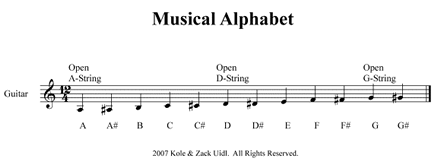
Before we get into any of the intermediate to advanced notational material, we first need to learn our Musical Alphabet. It's just like the normal alphabet, except it starts and stops from the letters A to G. We'll explain what all the lines, swirly things, and other pictures on here are a little bit later, but its important right now to just understand the musical alphabet. As you can see, it's made up of 12 pitches. Also, you will notice there is an "Open" indication over some of the pitches where an open string on the guitar is located. The Open A String is the first pitch you see there and is String #5 on your guitar played open (with no frets depressed). The same thing goes for the open D and G String correspondingly the open 4th and 3rd string on your guitar (in standard E tuning). That moves us to our next topic. It's also important to understand that once you get to G♯, everything repeats again so you start over with A again, but the sound is higher than it first was.
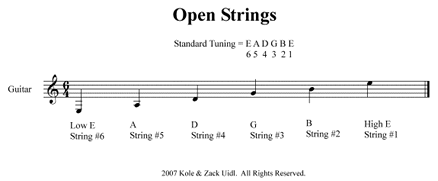
Open Strings If you play all 6 strings on your guitar without any of your fingers pressing down on any of the frets, then these 6 pitches (1 per string) are the notes you will get. Your lowest or thickest string is the Low E and can be found just below 3 lines below the staff itself. You might have to refer back to this chart every now and then, because I will give you some effective ways of reading and memorizing these notational examples. For now it's just important to know what pitch goes with which open string.
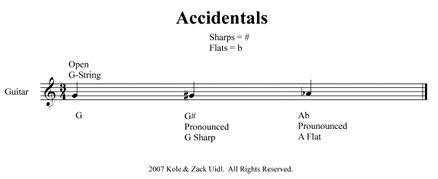
This example has to do with Accidentals. The two most basic accidentals are sharps and flats. As you can see in the example, the first pitch is just a normal G — in fact the open G string. When you add ♯ before the pitch on the staff, then that means you move up one half step, in this case G♯. So that means you will move your left hand from playing string #3 open (no frets depressed) to playing the 1st fret on string #3. If you moved one more half step (2nd fret) then you would reach the pitch "A" (Refer to Musical Alphabet Example). However, this example shows instead the pitch A♭. Whenever you see a ♭ in front of a pitch then that means you go a half step down from the originally intended pitch (in this case A which can be found on the 2nd fret of the 3rd string.) So to get the pitch A♭ you will move one fret down (from 2nd fret to 1st fret). If you are paying attention you will notice that G# and Ab are located on the same fret (1st fret of 3rd string). This is not a coincidence and is actually known in the musical world as "Enharmonically Equivalent." All that means is that, although they are spelled differently, G♯ and A♭ they are actually the same. It's also important to remember that while notating things on the staff (which is our next topic) you must place an accidental before the note itself. However, when you speak or write about accidentals, you must refer to the accidental after your original pitch. Example: it is "G Sharp", not "Sharp G".
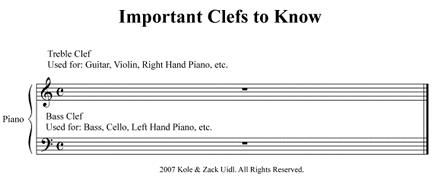
Welcome to the Important Clefs to Know example. As you can see there are two separate staffs with five lines going across the page. The Clef on top is called the Treble Clef or "G" Clef and is used for guitar, violin, and most of the higher pitched instruments. The treble clef usually contains higher pitches within the musical spectrum; however some of these notes will overlap with the Bass Clef. So this leaves the Bass or (F) Clef for the lower pitches and low instruments like double bass, cello, etc.
Since we learned our Musical Alphabet before in the last few examples, let's look at what pitches correspond with what lines or spaces for each of the clefs.
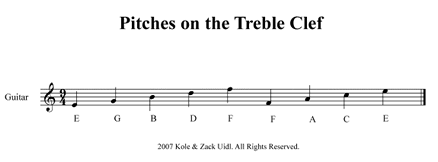
As you can see all of the lines and spaces in the Treble Clef have a corresponding pitch with them (which is always taken from the Musical Alphabet). The pitches corresponding with the lines spell (E, G, B, D, F). There is an easy way you can memorize this which they teach many young kids first learning about music (you might have heard of it while in school), but anyway it goes something like this: Every Good Boy Does Fine. If you remember that little sentence (learn the word) and remember that the first letter of every word corresponds with each of the lines reading from bottom to top, then you will be well on your way to reading music notation. The same thing works for the spaces on the Treble Clef, except it's a bit easier this time because the pitches themselves already spell a word that you can remember "FACE". Also, if you think about it — if you can count the alphabet, then you can find out any pitch on, below or above the staff. If you only remember E very and the "E" on the first line of the staff, then you can count up like you normally would to find any other pitch. For this example lets go to B. Starting at the first line the pitches go as follows (count spaces as well as lines!). E … F … G … A … B. The pitch B falls on the third line of the Treble Staff and counting like this works for everything. Just make sure to return to the pitch A once you get to G or G♯.
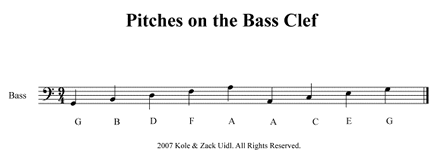
Most guitarists will never have to know the pitches on the Bass Clef, but I will go over them anyway. You can remember them just like you would in the first example except the pitches are a bit different with the lines and spaces this time. To memorize the pitches on the lines you could remember: Great Big Dogs Fight Animals. This is a bit silly, but it's an easy way to learn the pitches on the lines of the bass staff. Now to learn the spaces: All Cows Eat Grass.
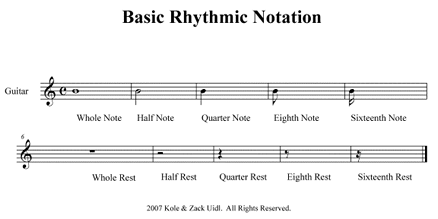
These are examples of common note durations. The system of notating rhythm (and how this example is set up) is very symmetrical and we'll explain a little bit about how you can understand it. Since this is common time, we will have 4 beats within a measure; respectively, each beat counts as 1 quarter note. We will base our understanding of rhythm off of this concept.
Whole Note = 4 Quarter Notes
Half Note = 2 Quarter Notes
Quarter Note = 1 Quarter Note
Eighth Note = 1/2 Quarter Note (it takes 2 Eighth Notes to get 1 Quarter note)
Sixteenth Note = 1/4 Quarter Note (it takes 4 Sixteenth Notes to get 1 Quarter note)
So as you are able to see, whole notes and half notes are longer in duration and eighth and sixteenth notes are faster in duration.
The system for rests is identical to the system for notating regular pitches, the symbols used are the only thing different. A rest is a time where nothing is being played.

The first measure shows eighth note triplets, which means 3 eighth notes fit into the time of 1 quarter note. The second measure shows 3 quarter notes which fit into the time of 1 half note — obviously this is irregular. Anyway, to notate triplets, you must group/bar the notes together and place a "3" above or below the notes to specify to the performer that these notes are to be played as triplets. That is all that needs to be done to notate triplets.
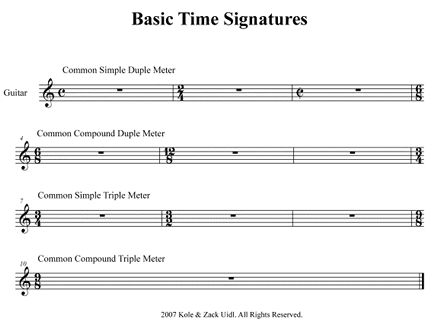
Time Signatures are numbers (fraction form) just to the right of the Treble Clef that you see in the example above. The Top number refers to how many beats there are within a measure. A measure is one vertical bar line to the next. The Bottom Number refers to what note type gets the beat. 2 = Half Note, 4 = Quarter Note, 8 = Eighth Note etc. So if we have the time signature of 6/8 then that is telling us that we will have 6 eighth notes in each measure.
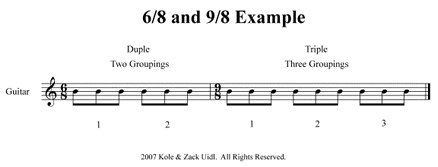
We'll now explain the titles given. There are two separate ways of classifying time signatures…that you can tell from the lower number given. If the bottom number is 2 or 4 then the Time signature is simple; however if it is 8 or 16 then you can consider it to be compound. The next classification has to deal with the top number and the grouping of notes. In duple meter you group notes into 2s or 4s. For example 6/8 is considered duple because you would notate two separate groups containing 3 eighth notes each. Triple meter, however, is the opposite and there are 3 separate groups when notating. 9/8 must be notated with 3 groups containing 3 eighth notes each. Refer to the example above to help understand.
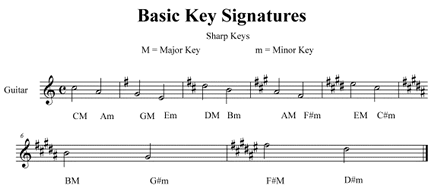
This next example assumes that you already understand what Major and Minor keys are and just need to learn how to notate them. Key Signatures are the ♯'s or ♭'s located after the Clef sign but before the Time Signature. These ♯'s or ♭'s correspond directly to the key you are working with and allow you to notify the person reading the score what key your piece is in ahead of time (plus you don't have to write a ♯ or ♭ every time you need one if you already have it marked at the beginning of the score!)
The example above shows you where to place the ♯'s and in what order for the Sharp keys. These work for both Major and Minor. Since you've memorized the notes as the correspond to the treble clef by now and you know that G Major only has 1 sharp (F♯), you will see in the example above that to notify the reader and make a correct key signature, you will need to place the ♯ at the highest line on the treble staff (appropriately and not coincidentally the pitch associated with this line is F and if you put a ♯ on it then every pitch placed on that line will now be played as an F♯ — the one ♯ pitch you need in G Major). The above example goes all the way to F♯ Major (although you can get C♯ Major), but most people tend to not deal with keys that have that many ♯'s in them. That's why I left it out.
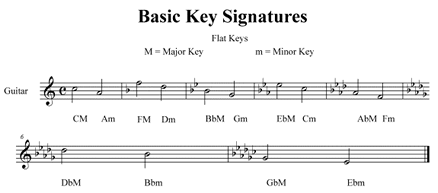
The information I listed above for sharp keys is exactly the same for flat keys, except this time you obviously use ♭'s instead of ♯'s. This is all assuming you understand keys and the pitches they contain.
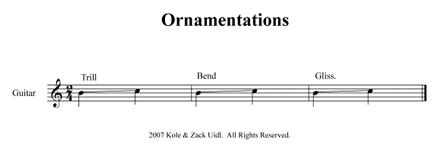
This next section deals with three main ways of ornamenting your music in notation for guitars: Trills, Bends, and Slides (Glissando).
Trills: To notate trills, you must determine what pitch you are to start at and then specify what pitch you would like to trill to. Most guitarists can't trill over a Major Third comfortably so you should keep that in mind. To notate a trill do exactly as the example has above by placing a line between the two pitches (B and C) and then write "Trill" above it.
Bends: Like trills, you must specify what pitch you want to bend from and, of course, your target pitch. In this case it is only a half step bend from (B to C); however, you should keep in mind that most guitarists can not bend over a minor third interval. Notation works the same way with connecting the two pitches with a line and saying "Bend" over the top of the measure.
Glissando/Slides: Slides are notated exactly the same way as the other two ornaments. However, you should place "Glissando" or "Gliss" (the abbreviated version) over the top of the measure. Slide range is quite flexible and the only thing you will need to keep in consideration is if it is idiomatic to slide from one pitch to the next. That is, does it stay on one string or not? If the answer is yes, then it is idiomatic and thus doable.

This next example shows us how to notate Articulations in music. The three main articulations used are: Staccato, Legato/Slur, and Tremolo. I'm assuming you all understand what these terms mean and their purpose. This example will just show you how to notate them. You do not need to write Staccato, Legato, or Tremolo above the staff like you would for ornaments.
Staccato: To notate staccato all you have to do is place a small dot over the top of the note head, effectively lowering the duration of the note. For staccato you shouldn't use long duration notes like half notes or whole notes. Quarter notes are the most common, but you can also use it on shorter duration notes like eighth and sixteenth to show separation in picking/tonguing.
Legato/Slur: To show phrase length and what notes should be connected with one simple pick or breathe of air, you should place an arch from one note head to the next.
Tremolo: Notating tremolo is really quite simple. All you have to do is place slashes through the stem of the note. The number of slashes you put does matter though.
- 3 Slashes = Unmeasured Tremolo (play as fast as you can)
- 2 Slashes = Measured Tremolo (4 times as fast, evenly divided)
*Quarter notes turn into sixteenth notes - 1 Slash = Measured Tremolo (2 times as fast, evenly divided)
*Quarter notes turn into eighth notes

A normal Repeat is notated by two dots before a double bar line and calls for the performer to go back to the beginning and play everything again.
The next two measures have a first and second ending. The way this works is that the performer plays through the piece up to the first ending, then goes back to the beginning and plays back to the same spot, but skips the 1st ending and goes straight to the second ending. You notate it just as it is shown in the example above.
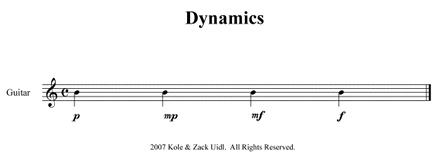
Dynamics tell the performer how loudly or softly to play the pitch (and those there after). To notate dynamics you should place the appropriate symbol (which is explained below), below the pitch where you want the new volume level to begin.
- p = pianissimo = play softly/quietly
- mp = mezzo piano = play moderately softly/quietly
- mf = mezzo forte = play moderately loudly
- f = forte = play loudly
This is the end of the Free Notation Guide, brought to you by Kole and Zack Uidl. We hope you have learned a lot about the basics of notation and as always, feel free to e-mail us (previous links) if you have any questions. Best of luck fellow musicians!
© Kole and Zack Uidl. All Rights Reserved. Used with Permission.
Click here to return to the full list of Zack's articles.
